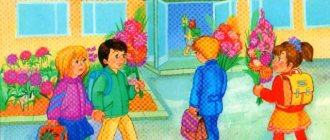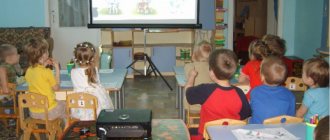Abstract of GCD Artistic creativity (modeling) TOPIC “Decorative plates for decorating a group”
TOPIC “Decorative plates for decorating a group”
Software tasks:
To develop the ability to creatively create an image based on a sense of form, selection and original combination of elements, color, in a unique composition.
Develop a sense of form, composition and the ability to create a pattern on any silhouette.
Create a desire to share joy, successful work with other people, a desire to give gifts to family and friends, using your skills in decorative activities
To develop children’s ability to sculpt decorative plates from a whole piece of plasticine using a plastic method.
Practice rolling a lump of plasticine between your palms, flattening it, and evenly pinching the edges
Introduce children to Khokhloma painting and its history. Fix to see and highlight the characteristic elements of the painting. Introduce the names of the painting elements: berries, flowers, curl, grass. Pay attention to the color scheme. Cultivate interest and love for folk art.
To cultivate respect for the traditions of Russian folk art.
Development in children of the prerequisites for a sense of patriotism, love, respect for the Motherland and people.
To cultivate respect for the traditions of Russian folk art.
Vocabulary work: exhibition, decor, exhibits, wood.
Materials: Khokhloma products, plasticine, stacks, surprise, music center.
Progress of the lesson.
Russian folk melody sounds
V. — Hello, guys, please say hello to our guests.
I suggest you play the game “Give a Compliment”, “Mood”
Today I invite you to the exhibition.
V. — Imagine that there are tickets on my palm. To take your ticket you need to touch my palm and say your name.
Children take turns coming up and saying their names.
V. - Does everyone have tickets? Go to the exhibition. This exhibition was created by the wizards - the artists of Golden Khokhloma.
All the leaves are like leaves,
Here, every one is golden.
Such beauty people
They call it... Khokhloma!
Music turns off
Our exhibition is completely unusual, unlike others - a unique exhibition. At our exhibition, objects can be picked up.
There are Khokhloma dishes on the table and shelves. I give the children objects to look at.
Q. - What do you think the products are made of? (children's answer)
These products are made of wood.
Q. - Why were they called gold? (children's answer)
They were called gold because the products have yellow leaves and a yellow background - similar to gold.
I’m telling you this while demonstrating a Khokhloma plate.
V. — Traditions in the manufacture and painting of products are passed down from generation to generation - to a son from his father, to a father from his grandfather. Bowls, bowls, and vases are first carved from wood and then prepared for painting. Cover with a thin layer of clay, dry the product, spread with oil and dry again in the oven, cover with drying oil, then rub with aluminum powder (silver). When the painting is finished and dried, the artist coats the product with varnish, and the silver under the yellow film becomes very similar to gold. This is how wonderful golden cups, bowls, vases and many other utensils are born.
www.prodlenka.org
Abstract of the GCD “Artistic Creativity” TOPIC “Decorative plates for decorating a group”
| Program objectives: To develop the ability to creatively create an image based on a sense of form, selection and original combination of elements, color, in a unique composition. Develop a sense of form, composition and the ability to create a pattern on any silhouette. To form a desire to share joy, successful work with other people, the desire to give a gift to family and friends, using one’s skills in decorative activities. To form children’s ability to sculpt decorative plates from a whole piece of plasticine using a plastic method. Practice rolling a lump of plasticine between your palms, flattening it, and evenly pinching the edges Download the full version of the abstract Introduce children to Khokhloma painting and its history. Fix to see and highlight the characteristic elements of the painting. Introduce the names of the painting elements: berries, flowers, curl, grass. Pay attention to the color scheme. Cultivate interest and love for folk art. To cultivate respect for the traditions of Russian folk art. Development in children of the prerequisites for a sense of patriotism, love, respect for the Motherland and people. To cultivate respect for the traditions of Russian folk art. Vocabulary work: exhibition, decor, exhibits, wood. Materials: Khokhloma products, plasticine, stacks, surprise, music center. Progress of the lesson. A Russian folk melody is playing. V. - Hello, guys, please say hello to our guests. I invite you to play the game “Give a Compliment”, “Mood”. Today I invite you to the exhibition. V. — Imagine that there are tickets on my palm. To take your ticket you need to touch my palm and say your name. Children take turns coming up and saying their names. V. - Does everyone have tickets? Come to the exhibition. This exhibition was created by the wizards - the artists of Golden Khokhloma. All the leaves are like leaves, but here, every one is golden. People call such beauty... Khokhloma! The music turns off Our exhibition is completely unusual, not like others - a unique exhibition. At our exhibition, objects can be picked up. There are Khokhloma dishes on the table and shelves. I give the children objects to look at. Q. - What do you think the products are made of? (children's answer) These products are made of wood. Q. - Why were they called gold? (children's answer) They were called gold because the products have yellow leaves and a yellow background - similar to gold. I’m telling you this while demonstrating a Khokhloma plate. V. — Traditions in the manufacture and painting of products are passed down from generation to generation - to a son from his father, to a father from his grandfather. Bowls, bowls, and vases are first carved from wood and then prepared for painting. Cover with a thin layer of clay, dry the product, spread with oil and dry again in the oven, cover with drying oil, then rub with aluminum powder (silver). When the painting is finished and dried, the artist coats the product with varnish, and the silver under the yellow film becomes very similar to gold. This is how wonderful golden cups, bowls, vases and many other utensils are born. V. - Guys, let's put the exhibits in place, I invite you to the second hall. There are empty shelves there. I pay attention to the children's reactions. V. - This is an unusual hall. You see that the shelves here are empty. This is a hall for beginners, young masters. Do you know how to sculpt from plasticine? Do you know what patterns are? Can you organize your own exhibition? D. - Yes, we will be able to organize our own exhibition. . Guys! Please look at the plates on the tables, are they as beautiful as this one? Why? That's right, they're not finished. And you young masters will have to work hard to complete the work so that the plates can be placed at the exhibition. Do you agree? Please sit down at the tables. Finger gymnastics Here are all my fingers, turn them the way you want: (Look at the open palms and twirl them) And this way, and this way, they won’t be offended in any way. (Rub our hands together) One, two, three, four, five, (Clap our hands) They can’t sit again. (Shaking the brushes) Knocked, (Knocked on the table) Twirled (Circular rotations with the brush) We wanted to sculpt. (Rub with hands) They will work a little, (Actively moving fingers) We will let them rest. (Put palms together) I give instructions to the children: It’s time for us to decorate the exhibition; whoever has finished, put the beautiful plates on the shelves. Now in the hall of young masters there are also products and are pleasing to the eye. You like? Our exhibition is ready. Which one of you will be a guide and tell you about your product: what color is the plate, what patterns are drawn? 1 – 2 children talk about their work. We had a wonderful exhibition. Did you like it? Do you want to further improve your skills? As a souvenir, I want to give a workbook “Khokhloma Painting” and a coloring book. This will allow you to become real Khokhloma masters. doshkolnik.ru |
GCD move.
Conversation between a teacher and children about the beauty of the winter forest . Questions for children.
- What time of year are we talking about?
- What do we see in the picture?
— What trees are in this forest?
— How can you convey the beauty of winter nature ?
Educator: Guys, you know how to paint a Christmas tree, and today we will learn how to make it from plasticine (shows the children a sample)
.
You and I have already prepared the background for our work, and now I will show you and tell you how we will make our Christmas trees.
Demonstration of modeling : we will make a column from brown plasticine, and this will be the trunk of our Christmas tree. Then we will pinch off a small piece from the green plasticine and roll it into a small ball, which we will place on the workpiece in this way. And now with my index finger I will smear this ball down a little, applying pressure. And now we have a fluffy twig. We will make the second row in exactly the same way from white plasticine (this will be snow)
. And we will make the needles into a stack.
But before we start, let's move a little and stretch our fingers.
In December, in December it will be cold outside.
And then all of us, guys, will put on gloves.
We'll put them on and then take them off again.
Children sit at tables and do work accompanied by quiet, calm music. Children who have already completed the work can be asked to depict falling snow (we make snowflakes from small pieces of plasticine. Snowflakes can also be attached to Christmas trees).
After the children have finished their work, offer to hang up all the work and look at it with the children. Celebrate the most successful ones and praise all children for their excellent work.
Modeling on a plate. Topic: “Winter Trees” Direct educational activity “Modeling” Topic: “Winter Trees” Program content. Cultivate a love for nature. Fasten.
Presentation “Development of creative abilities of preschoolers using non-traditional types of visual activities” The goal of my work was: development of creative thinking, creative worldview of preschoolers using non-traditional imaging techniques.
Source







